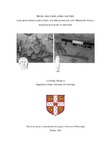This
research addresses the body and personhood in late Neolithic Malta (c.
3600–2300 cal BC) by reconstructing funerary practices at two collective
burial sites: the Xemxija Tombs (Malta) and Xagħra Circle (Gozo). The
range and sequence of funerary practices are identified through
implementing taphonomic analysis to classify the condition and
modification of bone and explore dominant trends in depositional
practice. Although the extensive disarticulation and fragmentation of
remains has received considerable attention, the timing of post-mortem
interactions has been largely overlooked. Yet, the temporality of
mortuary practices is crucial for understanding the social dimension of
the process of death and dying, revealing how the identity of the dead
is transformed. This work further explores how mortuary rites responded
to understandings of the body held during life. To do so, the treatment
of the dead body is placed in its social context, integrating burial
treatment, bioarchaeological evidence and material culture—particularly
the corpus of anthropomorphic figurines—to provide a new interpretation
of personhood in late Neolithic Malta.
Analysing the full assemblage of human remains from six rock-cut tombs
at Xemxija, and between 9.3–100% of the assemblage from 16 contexts at
the Xagħra Circle, this research finds a predominant practice of primary
interment and subsequent disarticulation in most burial spaces.
Disarticulation typically focussed on the selective removal of crania
and long bones, and long bones are demonstrated to have been removed
from the Xemxija Tombs. Careful analysis shows this was an extended
process, in which the memory of the dead was maintained over several
generations and social death was prolonged. Significantly, this practice
was inclusive of individuals from foetal to old adult in age and was
not biased according to sex.
Aligning the life-course with the death-course, a pervasive interest in
modifying the body is evident. The fragmentation of dead bodies and
figurines indicates bodily partibility enacted across multiple media.
These new results reveal corporeal practices which extended from life
into interactions with the dead. However, in all contexts, the body is
figured and constructed in diverse ways, revealing that personhood was
founded on difference. Altogether, bodies are shown to be complex and
multiple entities in both life and death, and the integration of bodies
in their varied forms was significant. This research offers new insights
into the ‘body worlds’ of Neolithic Malta which has implications for
understanding socio-political dynamics. This thesis demonstrates the
significance of a holistic analysis of bodies and personhood in the
past.
Keywords
Taphonomy, Funerary taphonomy, Personhood, Figurines, Deathways, Neolithic Malta, Collective burial
Rights
All rights reserved, All Rights Reserved











 Stumble It!
Stumble It!

No comments:
Post a Comment